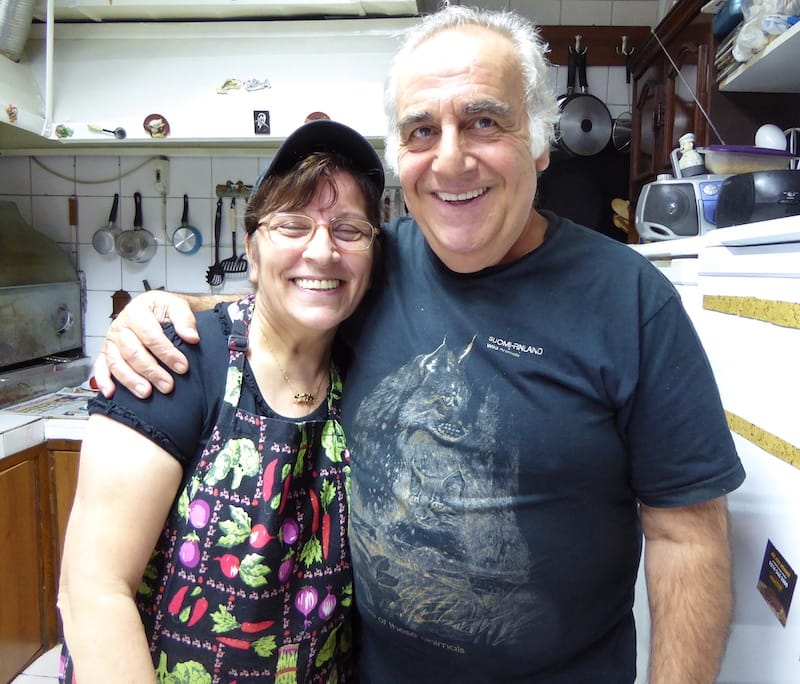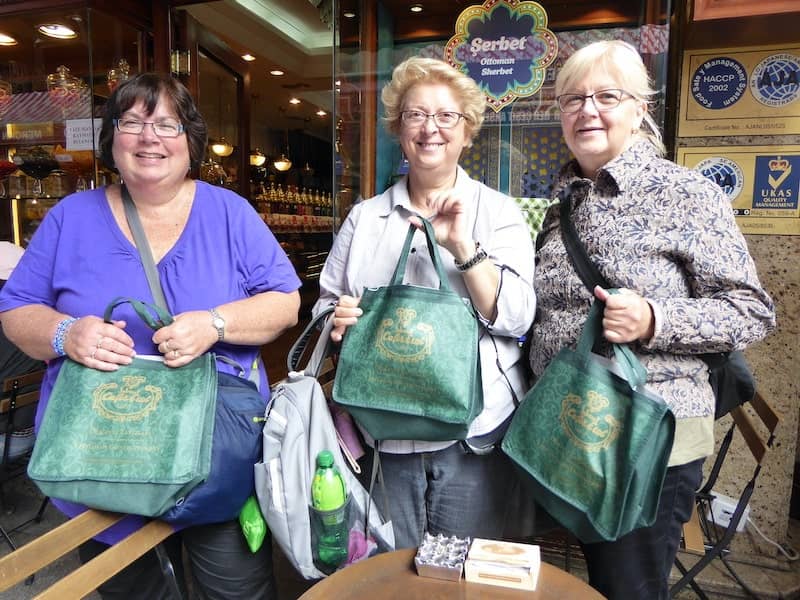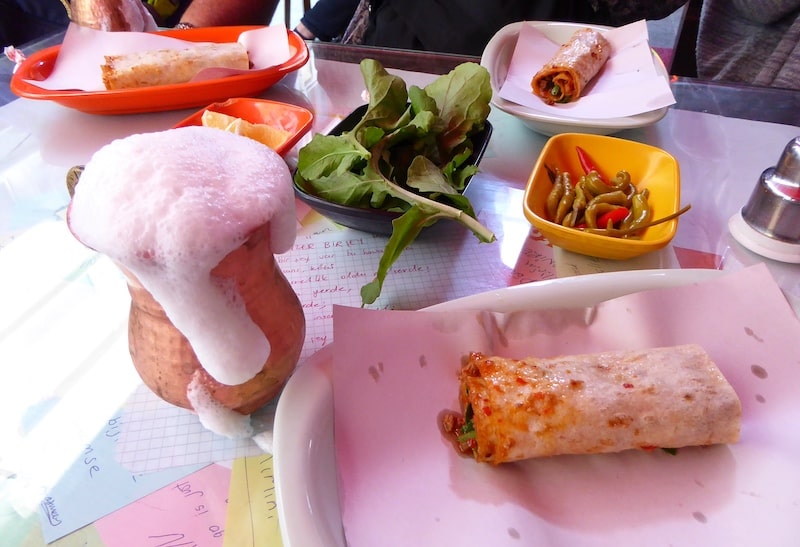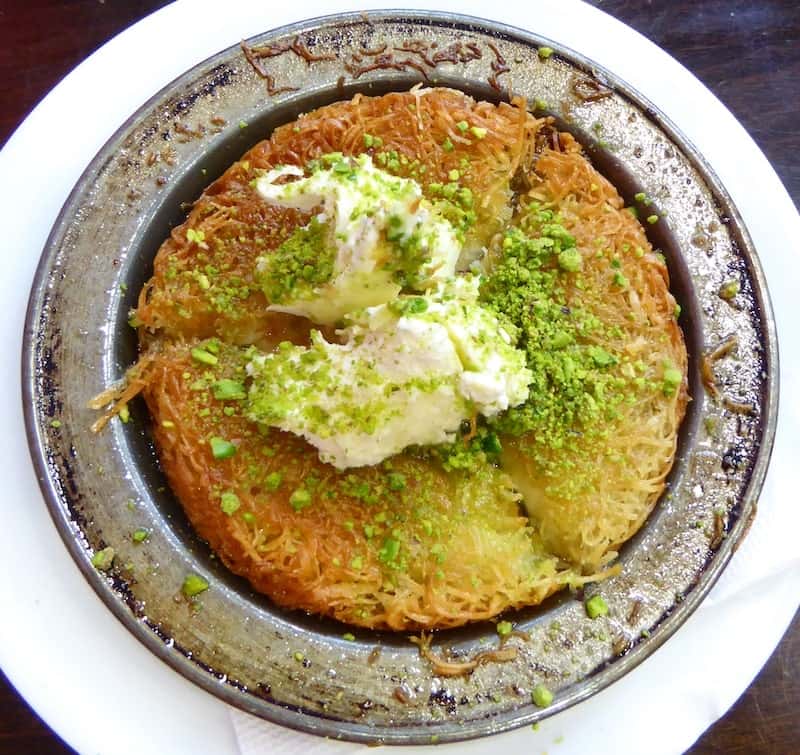Istanbul and Turkish food. Two favourites blend delectably in Istanbul’s ‘Two Markets, Two Continents’ food tour by Culinary Backstreets. It was an intriguing premise … breakfast in Europe, followed by lunch in Asia. Where else but in Istanbul could a culinary walk introduce participants to the tasty delights on a two-continent food tour on the same day?
A two-continent food tour
Food tours are a superb way to get to know a place. They’re about more than food. While skillfully navigating our small group through Istanbul’s culinary backstreets, our guide Esin interspersed relevant tidbits of Turkish history, culture, architecture, and politics.
It remains my favourite food tour of all time. It took me to neighbourhoods I wouldn’t have visited without a cultural interpreter, and foods I wouldn’t have tried otherwise.
1. Two breakfasts in Europe
It felt like a strange place to begin a food tour in the historic Perşembe Pazarı district in the working-class district of Karaköy. In the shadows of the Galata Bridge, the metalworkers’ precinct is dominated by welding and machine shops, and stores selling maritime supplies and hardware.
Our first stop was at Kurşunlu Han, an ancient Ottoman-era caravanserai. In a cozy corner tucked under sixteenth-century stone arches in what was once a bustling han, we enjoyed a typical working-day breakfast of tea and small bites. The staple simit (a Turkish sesame bagel) is a street snack commonly eaten on the run. Complementing the simit was aged kaşar (kassori cheese), olives from Antalya, and pastrami.
Tea served in the traditional tulip-shaped glasses was delivered to our table by a çaycı (tea waiter). Tea waiters have a prominent role in Türkiye’s tea culture. They support merchants and other traders by delivering tea for their customers; or workers and visitors to the neighbourhood. Tea tokens dominate the currency between customers and tea waiters; a customer usually makes a bulk purchase and pays for each glass of tea with a token. This avoids having to deal with cash or change.
Before moving to our second breakfast stop, Esin took us on a brief tour of the area. Besides learning more about the neighbourhood, it helped incorporate a little exercise and space between food offerings.
The second breakfast resembled one that would more likely be prepared on a non-working day, typically enjoyed with others and sprinkled with conversation over an extended period. A magnificent spread awaited us at Mutfak Dili (‘Kitchen Talk’), a tradespeople’s restaurant by the docks. It’s owned by a charming Armenian couple, Hayguhi Hanım and her husband Levon Bey. Hundreds of photographs of satisfied customers wallpapered the humble inside space, including one of Hayguhi and Levon with Anthony Bourdain.
It was a spread fit for royalty, of the Anthony Bourdain ilk — menemen (scrambled eggs with tomato, onion and peppers), tomatoes, cucumber, feta cheese, young kasseri cheese, salty cookies with olives and cheese, and a selection of jams (fig, rose, apricot, plum, and sour cherry). Clotted cream (kaymak) from the milk of water buffalo, a breakfast essential, is a taste of epicurean heaven when eaten with wildflower honey and crusty bread. It was the star of the show.
By this time, I was convinced we’d made an excellent choice in our selection of a food tour. The food was fantastic, and Esin’s commentary was a rich complement to the gustatory delights. The people behind the food, Hayguhi Hanım and Levon Bey, were delightful hosts and added to the meal’s appeal.
2. Time to cross to Asia
While crossing the Bosphorus on the ferry to the Asian side of Istanbul, Esin remarked that we hadn’t eaten for at least 15 minutes, and magically produced a tray of baklava from Karaköy Güllüoğlu. The bag prominently displayed the shop’s logo that included the year 1820. An establishment that has been making baklava for 200 years must be doing something right. After describing in great detail how one should correctly eat this 60-layer taste of phyllo heaven, my travelling companion Mary nailed it. We all agreed it was divine!!
Our first stop on the Asian side in Kadıköy taunted our baklava-stimulated taste buds. Esin guided us to the shop, Şekerci Cafer Erol, a confectioner, for lokum (Turkish delight), candied eggplant, and candied tomato. It was an ideal opportunity to stock up on boxes of lokum to take home.
This was followed by a visit to a fruit and vegetable stand for fresh fig to freshen our sugar-saturated palates.
3. Are we replete yet?
One might think by this stage that we couldn’t handle another drop of liquid or gram of food. That’s the thing about Culinary Backstreets — the company had structured the tour in such a way that we had room for more food and more information about Türkiye’s unique food scene.
We were in the heart of a local market, devoid of any evidence of offshore enterprises, and hardly a tourist in sight. It was dotted with independently owned eateries and shops selling fresh and preserved products. We were being immersed in a vibrant space where residents shopped, met up with friends over food and conversation, or men gathered to play the tile-based game, Okey.
I couldn’t wait to see where Esin would lead us next. It was The Pickle Shop (Meşhur Özcan Turşuları) to snack from a tray of pickled beets, cucumbers, carrots, cabbage, and plums with pomegranate molasses, grape molasses, and tahini paste on the side. The shop was a pickle lover’s paradise. Turkish people love the salty and vinegary taste of pickled vegetables. The wide selection on the shelves paid testament to this reality. We were introduced to a beverage comprising a tangy mix of various pickle juices. It was different, and definitely an acquired taste.
The next snack stop was at Koz Kuruyemiş, a dried fruit and nut emporium, for pistachios, hazelnuts, almonds, dried mulberries, apricot, and figs accompanied by walnut grape molasses.
I loved meeting the people behind the food. Wherever we went, we were greeted by friendly merchants and servers. Everyone seemed delighted to have us in their shops and eating establishments, enjoying the foods of Türkiye. Esin wasn’t the only one who wanted us to enjoy the food tour.
By this time, we were slowing down on the snacks. Slightly. There was no telling what delights were in our future and making room for them was definitely a priority.
4. Time to sit down to eat
Outside Gozde Sarkuteri, a delicatessen, we grabbed a table to enjoy four different mezes (small plates or appetizers). These included wrapped kale (pazı sarma), and deep-fried horse mackerel (istavrit balığı) from the nearby Kadı Nimet Balıkçılık fish market.
At Fazıl Bey’in Türk Kahvesi, we enjoyed Turkish coffee and chicken breast pudding (tavuk göğsü). Unlike in many western countries, coffee isn’t something to be grabbed on the run; Turkish coffee is to be lingered over, preferably with friends. Esin explained that it’s to be slowly sipped so the taste can be savoured and the grounds have time to settle.
Esin introduced us to Turkish fortune-telling. It involves turning the almost empty coffee cup upside down onto a saucer. Revolving the cup a few times in a clockwise direction allows what remains of the grounds to drip downwards to collect on the saucer. Then, a friend interprets the shapes and patterns formed by the grounds. It sounded like a fun way to end a coffee date with friends.
One of my favourite stops was at Kadıköy Tantuni for their Mersin-famous succulent beef tantuni and frothy yogurt drink, ayran. This popular street food is made from finely chopped stir-fried beef or lamb cooked on a round metal plate and combined with spices, parsley, onion, and tomato. It’s wrapped in a soft, fresh slice of lavash flatbread that captures the succulent meat juices. The salty ayran yogurt drink is a perfect complement to the tantuni.
Esin purchased a mini cake from Levon, a street seller, to add to the spread.
At Borsam Taşfırın, we grabbed some outdoor stools to enjoy two Turkish staples: lahmacun (Turkish pizza with minced meat)…
and pide (cheese, meat, and eggs in a flatbread). Both are incredibly tasty.
At Reks Büfe & Kokoreç, we tasted Yarım Kokoreç (a sandwich of sweetbreads — the intestine of lamb grilled with lots of spices).
At Kimyon Dürüm & Çorba, we enjoyed Kelle paça çorbası (soup of head and feet of cow, with tongue and cheeks) followed by Künefe, a sweet cheese pastry.
We ended the tour in Moda with ice-cream. Turkish ice-cream (Dondurma) is traditionally made with goat’s milk, orchid root, and mastic sap. It’s different, with a slightly chewy texture. It was delicious.
Conclusion
As mentioned, this was the best food tour I’ve ever experienced. Culinary Backstreets aced it. The company delivered in food value and in Esin, a guide extraordinaire. Even with a suggested list of eating establishments and foods to try, a self-guided option doesn’t come close to the guided variety. It was a ‘full’ day, so if you choose to book with Culinary Backstreets, wear your ‘eating clothes.’ It will leave you hungry for more of Türkiye and Turkish food, and undoubtedly a return visit.
If you found this post helpful, please share it by selecting one or more social media buttons. Have you taken a food tour in Istanbul? Would you like to share your experience in the comments? Thank you.
If Türkiye is on your travel list, the following posts might be of interest:
- What’s the best mosque to visit in Istanbul?
- 35 Best things to do in Istanbul for a memorable visit
- The fascinating story of Istanbul’s rainbow stairs
- Is ballooning in Cappadocia worth it?
- For the ultimate in relaxation, take a blue cruise on a Turkish gulet
Care to pin it for later?
This post is neither sponsored nor solicited, and I’ve received no rewards from Culinary Backstreets. I paid the full price for Istanbul’s ‘Two Markets, Two Continents’ food tour.






















Trackbacks/Pingbacks